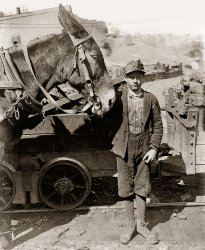
MAY CONTAIN NUTS

Search Shorpy
SHORPY ART

Framed or unframed, desk size to sofa size, printed by us in Arizona and Alabama since 2007. Explore now.
Join and Share
Ad-Free Shorpy
Shorpy is funded by you. Patreon contributors get an ad-free experience.
Learn more.

Recent comments
- Indiana Harbor Belt abides
- Freezing haze
- Corrections (for those who care)
- C&NW at Nelson
- Fallen Flags
- A dangerous job made worse
- Water Stop
- Passenger trains have right of way over freights?
- Coal
- Never ceases to amaze me.
- Still chuggin' (in model form)
- Great shot
- Westerly Breeze
- For the men, a trapeze
- Tickled
- Sense of loneliness ...
- 2 cents
- Charm City
- What an Outrage
- Brighton Park
- Catenary Supports
- Just a Little Before I was Born
- Afternoon normal
- The Flat Iron Cafe survives
- Aging in Place
- Raise your hand
- Good and Bad
- Oh, the 70's
- Nooooooi
- The aluminum tubing
Member Photos
The Shorpy
Print Emporium
Print Emporium
Search Shorpy
Search results -- 30 results per page
- Stoked: 1901
- ... light and power plants, street railway power stations, coal mining plants, blast furnaces, rolling mills, smelting and refining plants, ... Posted by Dave - 10/20/2012 - 10:49am -
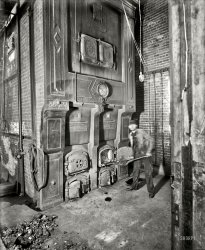
- National Tube Works: 1910
- ... artesian, salt, oil or gas wells, rods and columns used in mining, grate-bars, hand-rails, telegraph poles, gas and air-brake cylinders, ... a turnout and a turntable seems unlikely.
Those new coal ''gons'' belong to the Lake Shore & Michigan ... Posted by Dave - 07/29/2012 - 1:32pm -
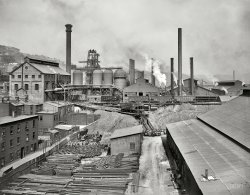
- Shenandoah: 1938
- ... County, Pennsylvania, 1938. "Shenandoah. House fronts in a mining town." Medium format acetate negative by Sheldon Dick. View full size. ... a land company laid out the town. The beginning of the coal industry brought English and Welsh miners, followed by Irish. Subsequent ... Posted by Dave - 10/15/2018 - 7:33pm -
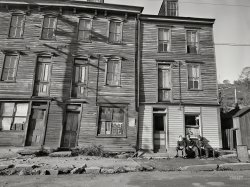
- Old Salts: 1910
- ...
Looks downright pleasant compared to working in a coal mine.
Oh the humidity! I hope they also have a Delray Rice Company ... barrels. Fifty men are employed.
(The Gallery, DPC, Mining) ... Posted by Dave - 08/08/2012 - 1:33pm -
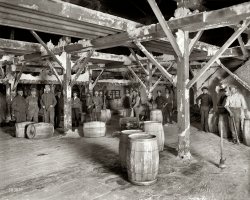
- America: 1900
- ... trip west to Virginia City -- the tale of Tom Quartz, the mining cat, is particularly precious and, not to forget, hilarious -- and on to ... into the 1980s. It was a small one used to shuffle coal barges around a loading terminal, and was most likely diesel powered. ... Posted by Dave - 08/20/2012 - 9:53am -
![America: 1900 "America, Mississippi riverboat, circa 1900-1910." Note the group of convicts in prison stripes. Detroit Publishing Company glass negative. View full size.
Sam'l Johnson would have loved it:Going to prison, with a chance of drowning, indeed!
ConvictsAre the convicts on the way to prison or did the riverboats use them as free or cheap labor?
SternwheelerI can never see a photograph of a paddle boat without thinking of Mark Twain. It's such a shame that these lovely ladies went the way of the dinosaur.
Mark Twain's river steamers.Contributor "heks" rightly mentioned Mark Twain. He worked as a river boat pilot for a while. You could do worse than read his book "Life on the Mississippi." Then read his follow-up book, "Roughing It," about his trip west to Virginia City -- the tale of Tom Quartz, the mining cat, is particularly precious and, not to forget, hilarious -- and on to San Francisco, thence to Hawaii. These are by far his best books -- and probably the least known! A superb photograph.
The ConvictsObviously they are being sent "up the river"
Mark TwainI've been thinking about Mark Twain during these, too. Finished "Life on the Mississippi" late last year, finished "Roughing It" this year. Interestingly enough, Mr. Clemens would leave us to believe the river boat was long dead by the 1870s-1880s, but the dates of these pictures show not so. Probably nowhere near the traffic levels at its height, but it takes a long time for a transport model to completely die.
Sternwheel LongevityThey actually lasted longer than most people think, though in a freight hauling capacity once passengers defected to the much faster railroads. But they pushed their share of barges after that. There was a working sternwheeler around Charleston WV on the Kanawha River (Ohio River tributary) into the 1980s. It was a small one used to shuffle coal barges around a loading terminal, and was most likely diesel powered. Used to see it all the time when I was out fishing.
Long-lasting river navigation.Contributor "Jim" is correct that it takes a long time for any form of transport to completely disappear. Here in New Brunswick, Canada we had stern-wheelers, side-wheelers and screw ships on the St. John River and the various arms of the river. The last run of the last serving ship, the Motor Ship D. J. Purdy, downbound from Fredericton, where I live, to Saint John, was September 30, 1946. The record runs of several of the boats on the St. John River were faster than the Canadian National Railways trains that pretty well followed the river! Granted, the railway was very much a secondary line, not a main line, but still . . . .
I have a set of the 1977 navigation charts for the river, very interesting.
S. S. KlondikeCanadian riverboats have shown up a couple of times in the comments, so I'll add my two bits.
The S.S. Klondike operated on the Yukon River until 1955. She presently sits on the bank of the Yukon River in Whitehorse, where I drive past her every day.
The Klondike has been meticulously restored by Parks Canada. If you are ever in this neck of the woods the tour is worth every penny.
More info here (there is some fantastic 8mm film shot in 1941 on that site).
[I've been to Whitehorse! The Yukon Territory and northern British Columbia are spectacularly gorgeous. - Dave]
Fire CanoesThere were steamboats (sometimes called "fire canoes" by the Native people) on the Saskatchewan River system from the 1860s into the 1910s. The last sternwheeler to work the lower South Saskatchewan was the City of Medicine Hat which had an unfortunate encounter with the Traffic Bridge in Saskatoon in 1908 and sank. Sternwheelers worked the Mackenzie River in the Northwest Territories until around 1940.
While it's true that train travel was faster and more efficient for passengers, it is also a fact that the most economical means for transporting bulk cargoes - in terms of cost of energy per ton of goods per mile is moving them by water...when you can. Sternwheelers then, tugs and barges today make a tremendous amount of sense.
Convicts on the SteamboatI did a little internet research, being curious about the convicts in the picture. This appeared in "Plantation Days at Angola: Major James and the Origins of Modern Corrections in Louisiana."
Until he died in 1894 (the lease survived him, not expiring until 1901), Major James ran what Dr. Carleton has called "the most cynical, profit-oriented and brutal prison regime in Louisiana history." Convicts worked on private property--both Major James's and that of other plantation owners who sub-contracted their labor --for the profit of the lessee, Major James. They worked the land, farming and cutting timber, they performed as household servants, they travelled not only "up the river" but down the river as well, on Major James's steamboat, repairing and building levees in the never-ending struggle to contain the Mississippi and protect the rich farmland.
History of Riverboat "America" 1910I would like to find more info concerning the Riverboat "America" during 1910. My grandfather worked on it as a carpenter but died in 1918. Since then all his children also are deceased but info in my father's writings stated the above info. There was another "America" but it collided with another steamship, flipped, and burnt at Warsaw, KY in 1890's.
(The Gallery, Boats & Bridges, DPC)](https://www.shorpy.com/files/images/4a17928u.thumbnail.jpg)
- Mineral County Coal Miners
- My great-grandfather's mining crew circa 1915 in Mineral County, West Virginia. His name was Thompson ... he is in the front row, crouched just to the right of the coal car tracks. The young boy in front of him was my great-uncle "Metty." ... Posted by RefugeRoad - 01/04/2008 - 9:55pm -
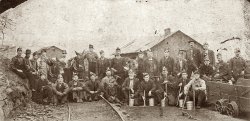
- Working Lunch: 1900
- ... Kingston, Pennsylvania, circa 1900. "Breaker boy, Woodward coal mines." 8x10 inch dry plate glass negative, Detroit Publishing Company. ... with this motivational poster:
(The Gallery, DPC, Mining) ... Posted by Dave - 08/20/2012 - 3:19pm -
![Working Lunch: 1900 Kingston, Pennsylvania, circa 1900. "Breaker boy, Woodward coal mines." 8x10 inch dry plate glass negative, Detroit Publishing Company. View full size.
Generous lunch breakTen minutes and all you can eat.
Cold RealityThere's nothing like this photo to give me a much-needed slap in the face when I start to complain about things. We all need to stop complaining, and be grateful that we Shorpsters aren't living this sort of life nowadays.
BuddiesDid this kid know Shorpy?
Lunch pailsHave you seen any on Ebay? Bet they would go for a pretty good price.
Lone wolfA previous Shorpy pic was shot at the same location and probably the same lunch break.
Illuminate meNot sure why a breaker boy would have an oil lamp on his hat. Didn't they work outside the mine in daylight? I'd guess he was a nipper or spragger or some other job inside the mine.
[Breaker boys worked in the breaker. -Dave]
Shiny things againAh, here we have a close view of the shiny things that had flummoxed me earlier. Now the question is, what's the round structure on the top? Other examples of early lunch pails I've located online have cups with handles attached like that, but these here are all much shallower.
Shiny thingsSince tterrace was flummoxed (I love that word!) I decided to see if I could google around and find anything similar. I say thats a miners lunch pail, even if the "cup" is quite shallow. Just like this one:
Poster BoyThank you for this great photograph! It made me think how much these kids suffered to make our day. They're actually our great-grandparents, who built our civilization on their backbones. So, I decided to honor them, most still unknown heroes, with this motivational poster:
(The Gallery, DPC, Mining)](https://www.shorpy.com/files/images/4a16386a.thumbnail.jpg)
- Woodward Breaker: 1900
- 1900. "Woodward coal breaker, Kingston, Pennsylvania." 8x10 inch dry plate glass negative, ... I do believe that it's a mule.
(The Gallery, DPC, Mining, Railroads) ... Posted by Dave - 03/03/2018 - 11:12am -
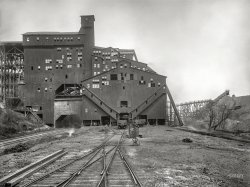
- Breaker Boys: 1911
- ... "Group of boys working in No. 9 Breaker. Pennsylvania Coal Co., Hughestown Borough, Pittston, Pennsylvania. Smallest is Sam Belloma, ... hand only. I imagine they looked down the belt as the coal approached and tossed the rejects to their left. The dust most certainly ... bless their memory.
(The Gallery, Kids, Lewis Hine, Mining) ... Posted by Dave - 06/24/2021 - 11:20am -
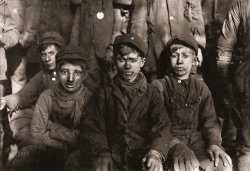
- Dark Room: 1938
- ... by four years. I was born in a one room cabin in the coal mining area. I suspect the cabin was similar. Morgantown, Ky. Dad worked the ... Posted by Dave - 04/07/2009 - 3:42pm -
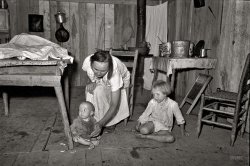
- Petersburg: 1864
- ... Regiment which was drawn from the Pennsylvania coal mining country. Pleasants himself was a mining engineer and he and his men had ... Posted by Dave - 07/17/2012 - 10:25pm -
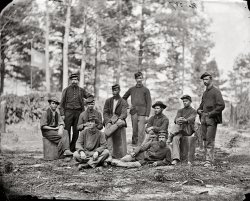
- I'm De Whole Show: 1913
- ... six messages a day is WAY better than some of the coal mining and factory situations we've seen here.
And I bet half the reason ... Posted by Dave - 08/13/2013 - 3:26pm -
![I'm De Whole Show: 1913 Waco, Texas. November 1913. Isaac Boyett: "I'm de whole show." The twelve-year-old proprietor, manager and messenger of the Club Messenger Service, 402 Austin Street. The photo shows him in the heart of the Red Light district where he was delivering messages as he does several times a day. Said he knows the houses and some of the inmates. Has been doing this for one year, working until 9:30 P.M. Saturdays. Not so late on other nights. Makes from six to ten dollars a week. View full size. Photograph by Lewis Wickes Hine. (Shorpynote: Isaac was born March 20, 1901, and died in May 1966 in Waco.)
IsaacGood to know that lamp was non-explosive ...
I love the look on this boy's face, and his world-weary eyes.
Not too bad - butI would bet that this kid gave the money to his mom, who probably had 6 or 7 kids to feed.
Not too badEight dollars per week in 1913 is the equivalent of about $160 today. About $8500 per year. Not bad for a 12-year-old.
Bike LightProbably not many bicycles today have kerosene lanterns on the handlebars. Fascinating.
Re: Bike LightAre you sure of it being a kerosene lamp? Looks like a carbide light like miners used to me.
Re: Re: Bike LightIt looks like one of the kerosene lamps below. Esp. the "Jim Dandy."
Bicycle LampsPeter Card has a richly detailed web site on early bicycle lamps. See the page, especially, on oil (kerosene) lamps, which I think is the type Master Boyett is sporting on his handlebars in this Hines photo.
Agree: this young lad does have world-weary, seen-it-all eyes.
Denny Gill
Chugiak, Alaska
[That really is a great Web site. Thanks for the link! - Dave]
1913 = today?Ok, how does a 1913 photo demonstrate child abuse "today"?
As far as child labor goes, I'd say riding a bicycle around and delivering six messages a day is WAY better than some of the coal mining and factory situations we've seen here.
And I bet half the reason he's grimacing is that he's facing into the sun.
TragicThis photo illustrates the failure of capitailism and the abuse of children that continues today in the USA. This child should be at home, playing and enjoying childhood while he can.
[Dumb comment of the day (so far). - Dave]
Ah, yes...The "good" old days. As bad as some things are now, at least we have very few 12 year olds spending all their time running messages for ladies of loose morals to their johns.
Reply to LC2You're right...now 12 year olds deliver crack cocaine instead of messages.
I'm going to start playing aI'm going to start playing a Shorpy drinking game and down a shot any time somebody grumbles about "kids today." Assuming my liver is up to it.
Messenger Boy in Waco, TexasThis is Joe Manning, of the Lewis Hine Project. I interviewed one of Isaac's daughters. I now have his interesting, but brief story on my website.
http://morningsonmaplestreet.com/2015/01/01/isaac-boyett/
(The Gallery, Bicycles, Kids, Lewis Hine)](https://www.shorpy.com/files/images/03910u.thumbnail.jpg)
- Where the Sun Never Shines: 1908
- October 1908. "Drivers in a West Virginia Coal Mine. Plenty boys driving and on tipple." Photograph and caption by Lewis ... shaft - they have room to stand up! The guys who cut the coal (hewers) would work on their knees or lying on their hips, swinging ... 1910 to 1955.
(The Gallery, Horses, Kids, Lewis Hine, Mining) ... Posted by Dave - 08/30/2012 - 7:46pm -
![Where the Sun Never Shines: 1908 October 1908. "Drivers in a West Virginia Coal Mine. Plenty boys driving and on tipple." Photograph and caption by Lewis Wickes Hine. View full size.
candlesThose are candles on their heads? Send the expendable ones down first!
[Gasoline or oil headlamps with open flames. More here. - Dave]
OopsAbout to be immortalized on film, and the one on the left shuts his eyes. It looks like he led a bit of a miserable life; shame he couldn't even get the photo.
Poor horse, too, of course.
[Both his eyes are open -- and closed -- in this time exposure. - Dave]
YikesI think this photo will give me nightmares. Just creeps me out.
The lucky onesThese lads and their pony are being photographed near the bottom of the shaft - they have room to stand up! The guys who cut the coal (hewers) would work on their knees or lying on their hips, swinging pickaxes for hour after hour, and breathing in all sorts of dust. Don't ever let anyone romanticise coalmining. I come from near Newcastle, and I know that the earth under my feet contains the bones of centuries of colliers. Horrible!
Son of a MinerThose are oil lamps on their heads, not candles. They also used carbide lamps. Don't feel too badly for the horses (usually mules), my dad said they typically worked shorter shifts. He worked in the mines at about this same era as a boy, from around 1910 to 1955.
(The Gallery, Horses, Kids, Lewis Hine, Mining)](https://www.shorpy.com/files/images/01064u.thumbnail.jpg)
- Shorpy Higginbotham: 1910
- ... of grease, and is often in danger of being run over by the coal cars." Photograph by Lewis Wickes Hine for the National Child Labor ... history and nostalgia!
(The Gallery, Lewis Hine, Mining) ... Posted by Dave - 02/14/2014 - 10:46am -
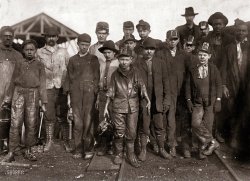
- South Pittston: 1911
- Shaft No. 6 workers at the Pennsylvania Coal Company's South Pittston mine. January 1911. View full size. ... my Granddad, an immigrant, went to work in a Pittston coal mine at the age of 14 as a water boy, and lived in Pittston for 18 years ... What a world.
(The Gallery, Kids, Lewis Hine, Mining) ... Posted by Dave - 08/15/2012 - 9:06am -
![South Pittston: 1911 Shaft No. 6 workers at the Pennsylvania Coal Company's South Pittston mine. January 1911. View full size. Photograph by Lewis Wickes Hine.
Pittston MinersThese photos wowed me because my Granddad, an immigrant, went to work in a Pittston coal mine at the age of 14 as a water boy, and lived in Pittston for 18 years before moving to Utica, New York. He "worked his way up," becoming a miner ... Does anyone know if the Pennsylvania Coal Company had the only coal mine in Pittston at that time? Or were there others? These photos may well have been the very place where my Grandfather started out his life here in the USA. Who knows, one of those kids in the pictures might be him!
[Very interesting! What year was your granddad born? - Dave]
American DreamGranddad was born in 1870 in poverty-stricken southern Italy and came to the USA in 1894 to Youngstown, Ohio, where he stayed only a very short time. He was then brought to Pittston, Pa., by his father, who had immigrated earlier and was working in the coal mine. Granddad started work there at the age of 14 as a water boy, then as a miner as he got older. He saved enough over the next 18-20 years to open a small grocery and then a private bank in Pittston, lending to new immigrants from different countries. Sort of the "American dream" story.
So young, so very young.So young, so very young. Their eyes have no light left, only reflecting. What a world.
(The Gallery, Kids, Lewis Hine, Mining)](https://www.shorpy.com/files/images/01144u.thumbnail.jpg)
- Serafino and Chub: 1911
- ... "Serafino driving Chub, his mule. Shaft #7, Pennsylvania Coal Company mine at South Pittston." Bright spots are open flames of lamps on ...
Mule Lifespan I wonder how long a mule lasted in a coal mine?
Ghostly Images of a Mine Amazing how this photograph seemed ... part of the mine.
(The Gallery, Horses, Lewis Hine, Mining) ... Posted by Dave - 08/14/2009 - 8:55pm -
![Serafino and Chub: 1911 January 1911. "Serafino driving Chub, his mule. Shaft #7, Pennsylvania Coal Company mine at South Pittston." Bright spots are open flames of lamps on the boys' hats. Photograph by Lewis Wickes Hine. View full size.
Serafino & ChubThis photo is so surreal. Serafino's eyes are amazingly creepy! Looming up from the darkness.
Sam KeysIt says Samuel Keys up the left beam.
[Funny. Doesn't sound Greek. But yes. I think you're right! - Dave]
S.K.While delta would be more sexy, I still think that if a girl was working down there, it'd read "S [heart] K [heart]". :)
AhhhI think this is the most terrifying picture.
Also, I think those are initials: S.K. You weren't being sarcastic, were you?
[It's S-delta-K-delta. With the name "Sami" underneath. Looks Eastern European/Bulgarian/Serbian/Turkish. - Dave]
Mule LifespanI wonder how long a mule lasted in a coal mine?
Ghostly Images of a MineAmazing how this photograph seemed to capture a gathering of ghostly figures at a dark, almost misty looking part of the mine.
(The Gallery, Horses, Lewis Hine, Mining)](https://www.shorpy.com/files/images/01100u.thumbnail.jpg)
- Bachelor Miner: 1937
- ... March 1937. Scotts Run, West Virginia. "Employed bachelor coal miner at home in Sessa Hill. This scene is typical of hundreds of ... emigrated from Europe in 1893 (naturalized in 1906), was a coal miner in Pennsylvania. Here’s his May 27, 1899, miner’s license, ... this is.
(The Gallery, Kitchens etc., Lewis Hine, Mining) ... Posted by Dave - 03/11/2013 - 12:12pm -
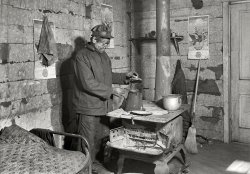
- Dave: 1910
- ... that Dave is a "pusher." What is a pusher's job in a coal mine?
I want to know more about him! Too bad all we have is his ... we have.
(The Gallery, Birmingham, Kids, Lewis Hine, Mining) ... Posted by Dave - 08/26/2011 - 3:49pm -
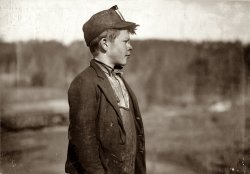
- Houses on the Hill: 1935
- October 1935. Coal miners' houses in Omar, West Virginia. View full size. 35mm nitrate ... was mentioned as a chicken coop could also be a wood or coal shed, wash house and possibly even a chicken coop. These were also most ... on your way to the outhouse.
(The Gallery, Ben Shahn, Mining, Small Towns) ... Posted by Dave - 09/09/2011 - 12:22pm -
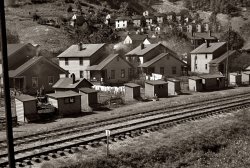
- New Jersey Zinc: 1911
- ... producing these small locomotives, with most of them being coal fired, while a few were oil fired. This one is most likely the former.
(The Gallery, Factories, Mining, Railroads) ... Posted by Dave - 06/21/2016 - 10:54am -
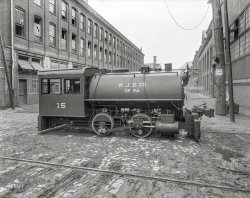
- Boy in Mudville: 1911
- ... 76 Parsonage Street, Hughestown Borough. Works in [coal] Breaker #9. Probably under 14." Photograph and caption by Lewis Wickes ... is apparently dying.
(The Gallery, Kids, Lewis Hine, Mining) ... Posted by Dave - 02/07/2011 - 10:22am -
![Boy in Mudville: 1911 January 1911. Pittston, Pennsylvania. "Tom Vitol (also called Dominick Dekatis), 76 Parsonage Street, Hughestown Borough. Works in [coal] Breaker #9. Probably under 14." Photograph and caption by Lewis Wickes Hine. View full size.
What's With That?Two names? Good thing Dave didn't find this photo first or our favorite photo site might have been called Vitol-Dekatis.
No need for colorThis is one of those pictures that I suspect would look pretty much the same taken with color film. The dreariness of the scene is accented by the contrast between the tight focus on Tom/Dominick and the soft focus of the surroundings. Very eloquent photograph.
One of those coincidences'Twas only yesterday, literally, that I re-read "Casey at the Bat", whence the origin of the pun "Boy in Mudville."
And nowThis was taken at the back of 76 Parsonage Street. The houses at the back are on Miller Street.
View Larger Map
Wipe those feet!Googling the location I think I found one or two houses that might be this one. The street does look bleak. According to a real estate listing, 105 has been fixed up nicely, on the market for $129,000. Pittston is apparently dying.
(The Gallery, Kids, Lewis Hine, Mining)](https://www.shorpy.com/files/images/01141u.thumbnail.jpg)
- Anthracite Alley: 1940
- ... August 1940. "Mauch Chunk, Pennsylvania. Small historic coal mining town in the Lehigh Valley. Houses in East Mauch Chunk." Acetate negative ... Posted by Dave - 04/05/2020 - 11:54pm -
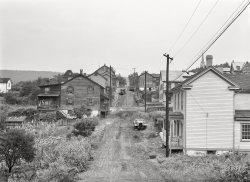
- Nanty Glo Slag Pickers: 1937
- Boys salvaging coal from the slag heaps at Nanty Glo, Pennsylvania. 1937. They get 10 cents ... by Ben Shahn.
Nant Y Glo Nant Y Glo is Welsh for Coal Valley
My Dad walked off seconds before the famous pic was made. ... funeral in 1988...
(Ben Shahn, Great Depression, Kids, Mining, NYC) ... Posted by Dave - 09/08/2011 - 11:31am -
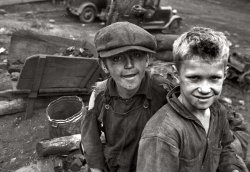
- Factory Town: 1910
- ... died, my mom took me to the small Pennsylvania coal mining towns (at that time) of Bradenville and Loyalhanna. I was very young at ... and everyone's emotions. Train tracks were everywhere and coal trains ran continuously. I'm sure it has changed now but this picture ... Posted by Dave - 07/29/2012 - 1:32pm -
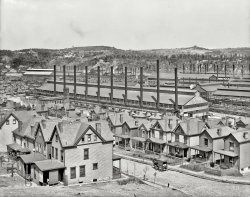
- Mountain Mamas: 1938
- September 1938. "Wife of unemployed coal miner, suffering from T.B., with her mother and children. Family living in old company store. Abandoned mining town of Marine, West Virginia." Photo by Marion Post Wolcott. View ... Posted by Dave - 10/17/2015 - 9:35pm -
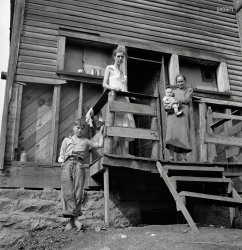
- Barnesville Mine: 1908
- ... pails. Trappers were boys who opened trapdoors to let coal cars pass and then closed them again to maintain proper airflow in the ... Well, it was my job.
(The Gallery, Kids, Lewis Hine, Mining) ... Posted by Dave - 07/27/2012 - 8:59am -
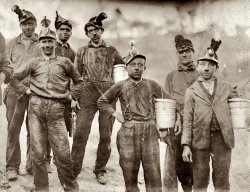
- Double Jeopardy: 1940
- ... by Jack Delano. View full size.
What Is Coal Dust and Cigarette Smoke, Alex.
Sixteen Tons If you see me comin', ... the left one will!
My Grandfather worked in the coal mines in the Lehigh Valley and contracted the black lung disease. My ... contact. - Dave]
(The Gallery, Jack Delano, Mining) ... Posted by Dave - 11/18/2018 - 4:03pm -
![Double Jeopardy: 1940 August 1940. "Miner at Dougherty's mine, near Falls Creek, Pennsylvania." Medium format acetate negative by Jack Delano. View full size.
What IsCoal Dust and Cigarette Smoke, Alex.
Sixteen TonsIf you see me comin', better step aside
A lotta men didn't, a lotta men died
One fist of iron, the other of steel
If the right one don't a-get you, then the left one will!
My Grandfatherworked in the coal mines in the Lehigh Valley and contracted the black lung disease. My grandmother told me when I was about 8 that she would place newspaper on the floor on his side of the bed at night because he would wake up and start hacking out some very bad black stuff. In the morning she would wrap up the newspaper and put it out in the trash. She did this for about ten years until he died just before WWII began. When he quit the mines he found a job as a train conductor on on the Lehigh Valley railroad and I wound up with his Hamilton pocket watch that he used as part of his job.
I'm originally from the patch. Very close to Mauch Chunk, now known as Jim Thorpe. This poor guy is probably about 17 years old.
Black LungBig Coal: "It's the cigarettes!"
Big Tobacco: "No, it's the coal dust!"
Tale of belt holesFrom the way the holes in his belt are worn it looks like he gained a bit of weight (the hole to the right of the one currently in use is stretched), then he lost a good bit (he had to punch a hole to make the belt even smaller than the last hole allowed), and now he's moved up to the last machine-punched hole again.
Troubles Come in ThreesIt is bad enough that he is exposed to coal dust in his work and that he could get lung cancer from the cigarettes but that tumor on his right eye needs to be looked at also. Poor guy probably couldn't afford to get medical attention.
[Or he smacked his head into something or someone. I had an egg just like that caused by head-to-pavement contact. - Dave]
(The Gallery, Jack Delano, Mining)](https://www.shorpy.com/files/images/SHORPY-8c03091a.thumbnail.jpg)
- Industrial Tableau: 1900
- ... the loaded United States - Ontario Steam Navigation Co. coal cars waiting for the boat, the port was also used for Northbound traffic ... Shenango No. 1 and Shenango No. 2, brought railcars of coal crosslake to Port Dover, Ontario. Conneaut hosted another carferry ... never been located.
(The Gallery, Detroit Photos, DPC, Mining, Railroads) ... Posted by Dave - 07/11/2016 - 10:11pm -
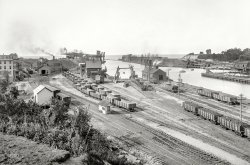
- No. 9 Breaker: 1911
- ... 1911. Boys working in the #9 breaker of the Pennsylvania Coal Co. mine at Hughestown Borough near Pittston, Pennsylvania. In this group ... real idea where it is.
(The Gallery, Kids, Lewis Hine, Mining) ... Posted by Dave - 12/10/2007 - 3:10pm -
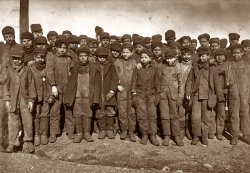
- Harry and Sallie: 1908
- ... West Virginia. "Harry and Sallie. Driver in Maryland Coal Co. Mine near Sand Lick. Was afraid to be photo'd because we might make ... View full size.
Maneless mule Mules and ponies in coal mines were shaved all over to keep them from collecting coal dust. Note ...
Great photo.
(The Gallery, Horses, Lewis Hine, Mining) ... Posted by Dave - 01/08/2009 - 11:46pm -
